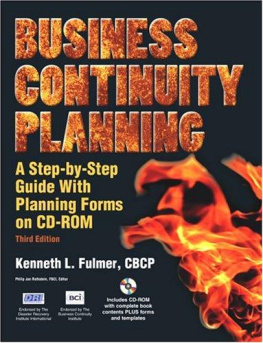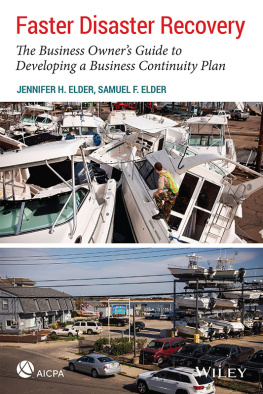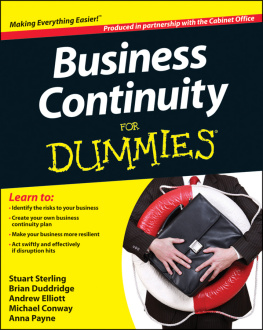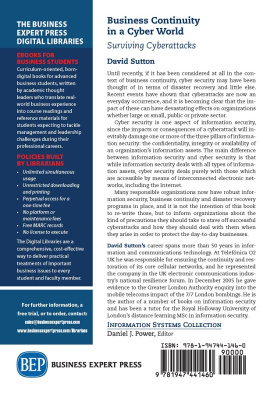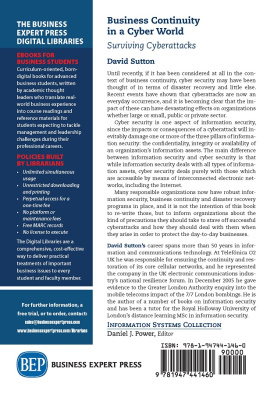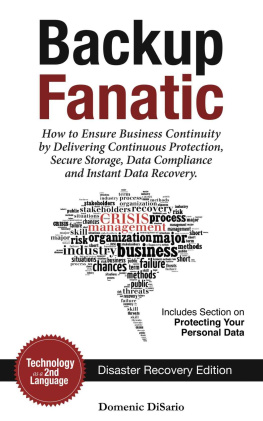Business Continuity Planning A Step-by-Step Guide with Planning Forms, Third Edition
Kenneth L. Fulmer, CBCP
Certified Business Continuity Planner
Philip Jan Rothstein, FBCI,
Editor
The Rothstein Catalog On Disaster Recovery Rothstein Associates Inc.
Brookfield , Connecticut USA www.rothstein.com
Copyright 19962005, Kenneth L. Fulmer
All rights reserved. No part of this publication may be reproduced or used in any manner without written permission except in the case of reproducing the worksheets for plan development purposes within one organization in accordance with the license statement below.
This publication is designed to provide accurate and authoritative information in regard to the subject matter covered. It is sold with the understanding that the Author and Publisher are not engaged in rendering legal, accounting or other professional service. If legal advice or other expert assistance is required, the services of a competent professional person should be sought. from a declaration of the principles jointly adopted by a committee of the American BarAssociation and a committee of publishers.
Disclaimer
The information, ideas and suggestions contained herein have been developed from research and many other sources, including publications. They are all considered and believed reliable but cannot be guaranteed insofar as they do not apply to any particular business or industry. Therefore this Author and Publisher specifically disclaim any liability for risk or loss, personal or otherwise, incurred as a consequence, directly or indirectly from the use of and application of any of the techniques or contents of this book.
In these guidelines, the inclusion of references to vendor concepts or methods is for information purposes only. The appearance or absence of a vendor or product in this publication should not be construed as an endorsement or non-endorsement of a specific vendor, product, methodology or company by the author or publisher, or any persons involved in the development of these guidelines.
No responsibility is assumed by the Publisher or Author for any injury and/or damage to persons or property as a matter of product liability, negligence or otherwise, or from any use or operation of any methods, products, instructions or ideas contained in the material herein.
License Statement
This book and accompanying CD-ROM are licensed to the purchaser for use in developing a plan within one organization. If using this document for a third party (client or customer of the licenser user), a separate book and CD-ROM must be purchased for each organization, client facility and or customer location.
ISBN 1-931332-21-5
Rothstein Associates Inc., Publisher
The Rothstein Catalog On Disaster Recovery
4 Arapaho Rd.
Brookfield, Connecticut 06804-3104 USA
203.740.7444 or 1-888-Rothstein (888.768.4739)
203.740.7401 fax
ABOUT THE AUTHOR
Kenneth L. Fulmer, CBCP, has been involved in the Business Continuity Planning field for over 14 years. He has been a member of the Disaster Recovery Institute International (DRII, www.drii.org ) since 1991 and a Certified Business Continuity Planner since 1992. Mr. Fulmer's career has spanned 27 years in the computer-related industry and has published, trained and spoken on business continuity issues.
Ken began his career as a public school teacher in Silver Spring, MD, and has since been a Bank Officer for Imperial Bancorp; now Comerica Bancorp, New York, and a National Account Executive with Digital Equipment Corporation; now Hewlett Packard.
Ken's Third Edition of Business Continuity Planning: A Step-by-Step Guide with Planning Forms on CD-ROM builds upon the foundation of the two previous, highly successful editions.
Melvyn Musson
FBCI, CBCP, CISSP
One of the first things that one needs to do when asked to write the preface to a book, is to determine what you feel the book's niche will be. In this case, the book has a very specific niche as a down-to-earth, practical "primer" or introduction to Business Continuity Planning, particularly for small and medium-sized firms.
It will also help answer the questions "what have I got myself into?" and "what is covered by Business Continuity Planning?" These are questions which someone with little or no Business Continuity Planning experience will ask themselves immediately after they are informed that they are now responsible for such planning within their firm, or that they are now charged with developing such a plan for the firm.
Other books can provide more depth of detail that may subsequently be needed, but this book will enable someone with little or no experience to start to put together a project plan, determine what they need to include in the initial structure of the plan and identify those areas that they may need to research further. Someone with more experience will find this book a useful resource to make sure they have covered all the bases. Worksheets, forms and action items are located throughout the book to provide that initial information base on which to build a plan.
This book provides the basic information to enable firms to start the development of their plans in the "classical" business continuity planning manner. Alternatively if one wishes to approach the plan in a different manner, possibly due to corporate culture issues, the book still provides an information base that can assist one in developing your own project and plan documentation.
One other advantage of starting with this book is that the reader starts from a simple beginning and can build to more detail, as that becomes necessary. This point is a key consideration. There is a tendency when developing a Business Continuity Plan to make it more complicated and detailed than may be necessary, particularly in small or medium-sized firms.
The Rt. Hon. David Blunkett, presently the Home Secretary in the United Kingdom Government, said recently in the Foreword to a new booklet "Expecting the Unexpected: Business Continuity in an Uncertain World" that Business Continuity and planning is just as important for small firms as it is for large corporations and that plans need to be simple but effective, comprehensive but tailored to the needs of the organization.
This book will put those, particularly in small and medium-sized firms, on the track to develop simple but comprehensive plans tailored to the needs of their organizations. Although written with an IT bias, one can extrapolate from the IT to determine what needs to be done by the business units or from an overall business perspective.
For those wanting to research Business Continuity Planning further, the Disaster Recovery Institute International ( www.drii.org ) and the Business Continuity Institute ( www.thebci.org ) have developed a set of Professional Practices for Business Continuity Planners. These comprise 10 subject areas of a common body of knowledge that characterizes the profession. Each subject area contains a description of the area, the role of the professional and an outline of the knowledge that the professional should demonstrate within that subject area.

